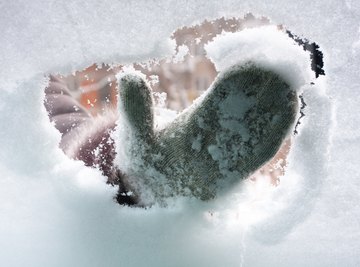
While extreme heat and cold both cause discomfort, exposure to cold temperatures is deadlier because at low temperatures, the human body loses heat faster than it is produced. Thinsulate, a thin, lightweight insulating material, offers varying weights with different temperature ratings. Factors such as thickness of insulation and the size and composition of the fibers contained within all play a role in how insulating a material can be, but when taking environmental factors into consideration, temperature ratings can only be relative to one another.
TL;DR (Too Long; Didn't Read)
While Thinsulate provides effective protection from the cold, it is impossible to determine absolute temperature values in every circumstance.
Heat Retention With Microfibers
Used in a variety of clothing items, Thinsulate comes in a variety of weights which all work by using a collection of microfibers that trap air molecules between the body and the outside material. The higher weights retain more heat. This trapped air is then reflected back toward the body, allowing it to retain much of its radiant heat. Compared to natural or polyfiber materials, these microfibers allow more air to be trapped in less space, resulting in both an increased insulating factor and the greater comfort and range of motion that is possible with less bulky outerwear.
While natural fibers such as down and cotton lose a certain amount of insulating factor when wet, Thinsulate is moisture-resistant. The microfibers retain their structure, unlike many other loft materials that can shift or clump and result in a reduction in the insulating factor. The company reports that repeated washings result in an unchanged “Clo” rating. Clo is the scientific measure of an insulation’s ability to keep one warm, one Clo is the amount needed to keep a resting person warm in a 70 degrees Fahrenheit room with no wind.
3M, the company that created Thinsulate, does not provide exact warmth ratings (i.e., numeric temperature limits) on its products. It would be impossible to do so with a reasonable level of accuracy because insulating properties vary with circumstances. Many factors affect how a body uses and loses heat. Considerations such as the outdoor temperature, altitude, wind speed, humidity, duration of exposure, an individual’s physical traits, activity level and the combination with other clothing worn all impact the resultant insulating factor of an article of Thinsulate clothing. Some manufacturers that produce items made from Thinsulate do offer temperature guidelines, based on tests using a heated manikin, but even while strictly adhering to ASTM International Test Standards, determining these measurements is a complex process and the result does not reflect all possible contingencies. Further, these tests are only accurate when limited to adult articles of clothing that cover a substantial amount of the body.
References
- 3M: What Is Thinsulate Insulation?
- Reflective Apparel Factory: 3M Thinsulate Insulation
- ASTM International: ASTM F2732 - 16 Standard Practice for Determining the Temperature Ratings for Cold Weather Protective Clothing
- Environmental Health Perspectives: Between Extremes: Health Effects of Heat and Cold
- ASTM International: ASTM F1291 - 16: Standard Test Method for Measuring the Thermal Insulation of Clothing Using a Heated Manikin
About the Author
Kimberly Yavorski is a freelance writer with a passion for learning, especially about nature, outdoors and the natural sciences. A longtime student of the life sciences, she served as a leader for Girl Scouts and 4H, sharing her interests by teaching children and teens about natural and environmental science and animal anatomy. Her work has also appeared on LetsGetOutside.us and Happy Science Mom. She can be found at www.kimberlyyavorski.com.
